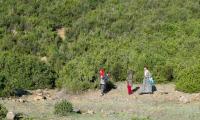According to news reports, the federal government has decided to gradually merge the Federally Administered Tribal Areas (Fata) with Khyber Pakhtunkhwa (KP) in the next five years.
The initial duration required for the merger was 10 years. However, political parties have exerted pressure and are pushing for the merger to be put into effect before the 2018 general elections. This proposed merger requires research and extensive consultations with all stakeholders to remain successful. Any haste in this regard will result in disastrous consequences. There are several serious questions which need answers in the planning stage.
Fata comprises seven tribal agencies – Khyber, Kurram, Orakzai, Mohmand, Bajaur, South Waziristan, and North Waziristan. All these tribal agencies, except Orakzai, are situated along the Afghanistan border. The six frontier regions (FRs) of Fata are located in six districts of KP. The population of Fata is around three million, as per the 1998 population census. This low population may be an outcome of either the migration of Fata’s people to the settled parts of Pakistan and the Gulf states or errors in the population census.
There are several commonalities between Fata and KP. A majority of people in Fata are Pakhtuns and Muslims. In KP, a majority of the population is Pakhtun and almost all of them are Muslims. The governor of KP simultaneously manages KP as well as Fata. Several KP government departments also operate in Fata.
There are also considerable differences between both regions. Although these KP and Fata are geographically close to each other, their population has been living in completely different systems for a long time. The people of KP live under an administrative system of the police, patwari, the judicial system of courts, and a political system which constitutes political parties and the provincial assembly. Meanwhile, the people of Fata have been leading their lives under the system of political administrations where the political agent (PA) is an administrator, judicial officer and revenue officer, etc. Under the PA system, Fata’s people have been living like slaves but still have the independence to lead their lives under their own customs and traditions called the rewaj. The humiliation that accompanies the police, lower court, and patwari systems will not be acceptable to them.
How will Fata’s people reconcile with these systems? A long time has passed since the merger of East Germany and West Germany. But Germans still live like two different waves in a river because both regions previously operated under different systems. The merger of Hong Kong with Mainland China is also another example.
But the people of Fata have regular interaction with the prevailing system in KP and know its pros and cons. Fata has a limited area which is under direct government control. There is a large area in the tribal belt which is inaccessible and lacks government control. For example, Tirah Valley is akin to a black hole. This valley is large, inaccessible, remote, and mountainous and lies among three tribal agencies of Khyber, Orakzai and Kurram along with Afghanistan. There are also other areas, such as FR Kurram, and large chunks of areas in each tribal agency which are inaccessible. This raises a serious question as to how the KP government will administer these inaccessible areas.
The Fata Commission’s report recommends developing the tribal belt and to bringing it at par with KP. Fata is currently a war-torn region after the Afghan war and countless military operations. It is now in a worse condition than it was 30 years ago. Its physical infrastructure has been destroyed. Economic opportunities never existed in Fata. Even the most developed tribal agency lags behind the least developed district of KP. What strategy will be implemented to bring Fata at par with KP?
If, under these circumstances, Fata is merged with KP, it will place a huge economic burden on the already poor, terrorism-devastated province KP. There is no revenue collection system in Fata. According to an estimate, more than 50 percent of the region’s population is living below the poverty line as compared to 30 percent in the remaining parts of Pakistan. Only a strategy that is similar to the Marshall Plan can help develop Fata – and that does not seem to be anywhere in sight.
Political parties are interested in reaching out to the people of Fata. But corruption scandals, inefficiency and nepotism are not making them favourable choices among the people of the tribal belt. An agency-based local government system may be a good way to introduce the political process in Fata.
Large provinces also create big problems of governance. The existing ethnic balance may be disturbed due to this merger. At least 60 percent of KP’s population is Pakhtun but the remaining 40 percent constitutes other ethnic groups – such as Hindkowans, Seraikis, Chitralis and Kohistanis. According to the 1998 population census, 80 percent of Hazara Division’s population is Hindkowans while 60 percent of DI Khan’s population is Seraiki-speaking. Even an increase in the number of Pakhtuns will give a further boost to the demand of establishing a separate Hazara province.
The introduction of high court benches in Fata has also been proposed. It is a costly system to implement and delays in decision-making remain common. How will the people of Fata adjust to this system as compared to their own jirga system? The Frontier Crimes Regulation (FCR) – whereby an entire tribe is punished because of a crime committed by one person – has been heavily criticised. When Israel tried to introduce a similar system in its occupied Palestinian areas, it was condemned by the entire world.
Every aspect of the merger of Fata with KP should be thoroughly, minutely, and comprehensively studied before it is put into effect. Any action that is taken in haste – due to pressure from political parties or other interest groups – will have disastrous consequences for the people of Fata.
The writer is a Peshawar-based academic.
Email: alishahzadpk4@yahoo.com
There are over 11 million Pakistanis settled abroad, out of which around six million work in Gulf and Middle East
This year alone, US Treasury would have to roll-over $10 to $14 trillion in maturing short-term debt
Tear gas no longer marks just protest sites; it paints entire cities as battlegrounds but then again, PTI did it first
Political structures and governance systems have been central to economic and social development
It is confirmed now 40 Pakistanis had died after boat of migrants had capsized in sea near Greece
Many people believe that in future, AI will play an even more significant role in their lives







